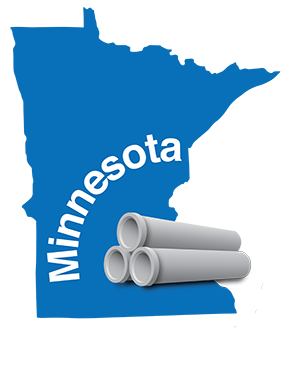
MnDOT Storm Sewer Pipe Comparison at a Glance

Typical Minnesota TRENCH DETAILS: Concrete & Plastic Pipe


Typical Minnesota INSTALLATION & POST-INSTALLATION INSPECTION REQUIREMENTS: Concrete and Plastic Pipe
C.3 Concrete Sewer Pipe
Lay concrete pipe with the female end of each section upgrade. Tightly join the pipe sections so that the interior of the pipe sections abut each other.
Use preformed rubber or bituminous mastic elastic joint sealer material to provide flexible water-tight joint seals for concrete pipe. Where the pipe is designed to accommodate preformed gasket type seals, seal the joints with the preformed gasket as shown on the plans and meeting the performance requirements of 3726.
Where the pipe is not required to accommodate preformed gasket type seals, seal the joints with bituminous mastic and a full circumferential wrap of geotextile material extending at least 1 ft on each side of the joint. Secure the circumferential wrap against the outside of the pipe by metal or plastic strapping or by other methods approved by the Engineer.
Apply mastic joint sealer materials as recommended by the manufacturer. Wipe joints clean on the inside after sealing.
Plug lifting holes with a precast concrete plug, sealed and covered with mastic or mortar.
Use approved fasteners shown on Standard Plate 3145 to tie together concrete pipe sections unless otherwise shown on the plans or specified in the special provisions.
Provide backfill material in accordance with the plan, modified to 100 percent passing the 3 inch sieve within 2 ft of the pipe.
C.4 Plastic Sewer Pipe
Follow minimum cover, maximum cover and installation requirements shown in detail “PLASTIC PIPE INSTALLATION REQUIREMENTS”.
Provide embedment material in accordance with the plan, 3149.2.D.1, “Granular Backfill,” modify gradation to 100 percent passing the 1 inch sieve. Use the embedment material to provide 1 ft of fill over the pipe and fill for a trench width as specified by the contract.
Place pipes and backfill in dry conditions by controlling the water conditions. Dewater groundwater and surface runoff to keep the water level below the pipe foundation.
Place pipes on the bedding starting at the downstream end of the pipe installation with the female end of each section upgrade.
Make connections with bell and spigot joints using an elastomeric rubber seal (gasket) to provide water-tight joints that do not allow soil, silt or water to migrate through the joint. Install joints so connected pipe sections form a continuous surface free of irregularities in the flow line. Tightly join the pipe sections so that the interior of the pipe sections abut each other. Keep gaskets and joint surfaces clean and free from soil during installation. Follow manufacturer’s recommendation for fitting or coupling assembly and installation. Use a lubricant, if required, that will not have deteriorating effects on the gasket and pipe materials.
Before allowing vehicles or heavy construction equipment to travel over the pipe trench, maintain a minimum cover depth of material above the pipe of at least 2 ft and meeting the requirements of AASHTO LRFD Bridge Construction Specifications, Section 30, Table 30.6-1.
Perform deflection testing of all plastic pipe at least 30 calendar days after installation. Remove obstructions including sediment, standing water, or other obstructions that would interfere with mandrel testing prior to deflection testing. Dewatering and additional work associated with preparing for and performing deflection testing is included in the bid price of the pipe.
Evaluate the pipe to determine if the specific internal diameter of the barrel has deflected more than 5 percent. Use the following methods to perform the deflection test unless otherwise specified in the plan:
(1) Visual inspection alone is not allowed for deflection testing.
(2) Use a nine-point mandrel approved by the Engineer to perform deflection testing for pipes with an inside diameter 2 ft or smaller. Pull the mandrel through the pipe using non-mechanical means.
(3) Direct measurements cannot be used for deflection testing unless specified in the plans and approved by the Engineer. Direct measurements can only be used on pipes with an inside diameter of 30 inches or greater. If the Department allows direct measurements, the Engineer must take measurements at randomly select locations, but at a minimum once every 10 ft throughout the pipe length and at the pipe ends. Visually inspect the pipe and take additional measurements at any location of observed anomaly or deflection. Ensure personnel making direct measurements meet confined space entry requirements in accordance with 1706, “Employee Health and Welfare.”
(4) Laser scan inspection (laser ring) can be used to perform deflection testing when specified in the plans and approved by the Engineer.
The Engineer will consider pipe that has a deflection of greater than 5 percent in the pipe or is damaged. Remove unacceptable pipe and install new pipe or undamaged deformed pipe. Re-test the re-laid pipe for deflection after at least five calendar days after installation.
Send deflection testing results to the State Hydraulic Engineer with the S.P. number, pipe location, material type, size, date built, date tested, and results from the mandrel test or other deflection test.

